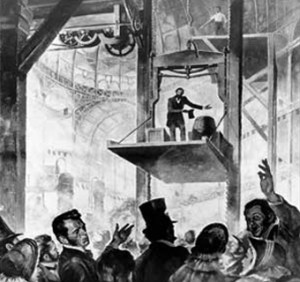 A little historical trivia for you: What do these structures have in common: The Eiffel Tower, the Kremlin, the Washington Monument, the Royal Palace in Madrid. (If you get this right, call Alex Trebek immediately!)
A little historical trivia for you: What do these structures have in common: The Eiffel Tower, the Kremlin, the Washington Monument, the Royal Palace in Madrid. (If you get this right, call Alex Trebek immediately!)
The answer is they all have Otis elevators installed, whisking passengers to the top.
Why am I thinking about elevators? As Casey Ross reported in the Globe Wednesday, Boston is poised to get its newest skyscraper, and that will mean some slick, fast new elevators, no doubt.
From Ross: Developer Richard L. Friedman will formally kick off construction of the tallest skyscraper to be built in Boston in 40 years — a 700-foot tower at 1 Dalton St. that will include the city’s second Four Seasons Hotel and some of its most expensive condominiums. “This will be the highest quality ever built in the city,” said Friedman, chief executive of Cambridge-based Carpenter & Co.
A new skyscraper is a good opportunity to revisit why we have skyscrapers today at all, and the reason, largely, is because of Elisha Graves Otis. I wrote about Otis in the first 10 pages of “The Race Underground,” in my favorite chapter called “The Secret Subway.” Before he came along, in the mid-to-late 1800s, the tallest buildings were typically eight to 10 stories, not much more, as climbing any more stairs than that was not practical.
The chapter tells the story of Alfred Ely Beach and William “Boss” Tweed and their epic feud over a subway project in Manhattan. The American Institute Fair was a huge annual event in the mid 19th century, and that’s where Beach unveiled his subway proposal, and it’s also where that clever mechanic named Elisha Otis unveiled his.
It was at the fair in 1854, where I write about this moment: “Otis showed how climbing hundreds of stairs no longer had to be an obstacle for cities to grow up. His elevator, a new invention that was pulled up by ropes, could not only be safe, but it would herald in the age of buildings much taller than eight, ten or twelve stories. With a crowd standing around his elevator, Otis rode it to its highest level, and, for the riveted audience below, reached out and cut the elevator’s only rope. Instead of plummeting down, he fell only a few inches and then stopped, showing everybody how the safety catch he had installed worked.”
Today, Otis United Technologies is a worldwide leader in elevators, 150 years old with more than 60,000 employees worldwide. And it all started back at the American Institute Fair. After Otis finished his daring demonstration, sales of his elevator shot, ahem, up. He sold seven devices in 1854 and 15 in 1855, and kept climbing from there.
So the next time you step in to an elevator, push your floor button and watch as those doors whoosh close, then maybe say a little thanks to Elisha Graves Otis for saving you from trekking up a whole lotta stairs.
